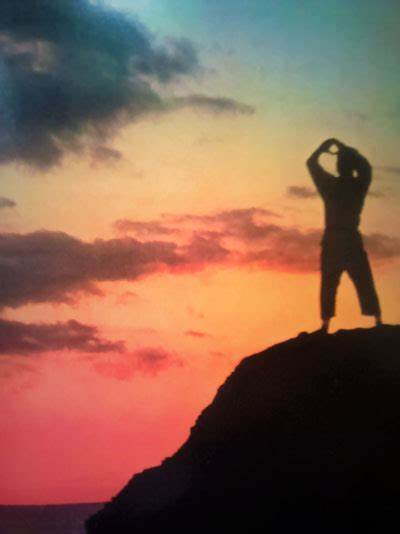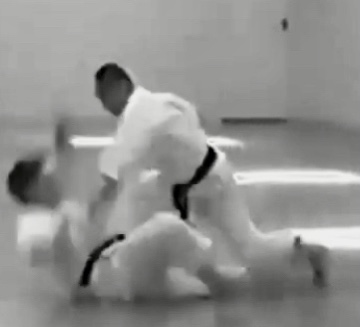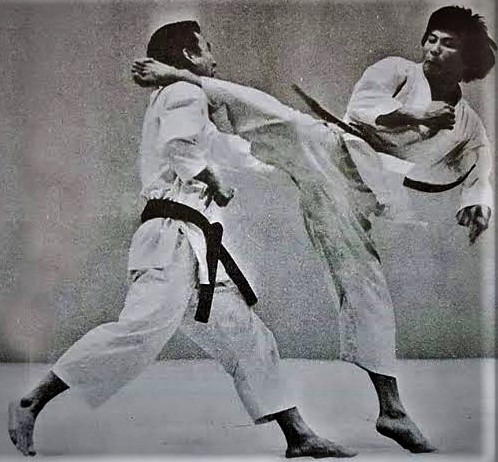Following up from my last article here is
a technical summary of Kanku Dai Kata. The numbers convey the correct command
count, which is optimally for perfecting ‘kime’ in every waza. This is
especially notable in renzokuwaza (combination techniques) and, in particular,
in the first movement of sequences. All too common, in sports karate, this
action is weak and ineffective. This is because the aim is to artificially make
more rapid actions in order to appear more explosive/dramatic. This type of
movement must be avoided at all costs for those seeking budo karate as it not
only has no meaning, but also provides an obvious gap in one’s defense.
Kata are not ‘for making bad habits’, so each waza must be maximumly effective. Every time the aim is ICHIGEKI-HISSATSU, which is the only way one can seek optimization in every action. While there is a literal meaning in this, more importantly, the relentless chasing of this technical ambition is what drives the budo karateka forward in their development/refinement of technique, physicality, mentality and heart.
Finally I’d like to mention ‘variations
of kata’ between different organizations, dojo (plural) and individuals.
Obviously, this is not only for Kanku Dai, but all kata and karate waza. One
thing you will easily notice is the Kanku Dai of JKA is different from SKIF,
likewise the JKS version is different from both of these groups. I could go on;
however, I think it is fair to say that there are subtle—and sometimes not so
subtle—differences between individuals, clubs, groups etc...
Hey you! Your shuto uke is too
extended!!! That’s wrong! So and so Sensei in Japan said ‘this is correct’.
This type of thing is OK when we are talking about beginners and intermediate
level karateka. At these stages one needs strict guidelines to acquire a line
of reference. But the individual must grow and moderate themselves—to literally
optimize themselves as budoka—from the standardized versions.
I personally respect ALL VARIATIONS as
long as they are pragmatic in application and avoid superfluous actions. As an
instructor, I teach the way I was taught; however, I avoid correcting
variations which are equally effective. In saying that, I will teach my way if
karateka are interested. When this occurs, I recommend that they experiment and
find the best way for themselves. I could never say to someone that Kanazawa
Hirokazu Sensei’s version of any kata is wrong, likewise Yahara Mikio Sensei et
al. I have deep respect for all of these groups and variations, which are
steeped in budo karate.
That is why, in a grading, if one
presents a rendition of a kata—which is different from mine—if it is correct in
the budo sense and of the appropriate level for the respective grade, I cannot
fail them. To do so would be folly; moreover, representative of the commercial
monopoly which, so often, organized karate is.
Rather with our necks tilted, eyes and
minds looking at the ground, we should be LOOKING AT THE SKY. On that note,
here is Kanku Dai generically summarized.
KANKU DAI
REI (Musubi dachi).
YOI (Hachiji dachi)—Ryo te kafukubu mae.
- Ryo
te hitai mae ue (Hachij dachi).
- Ryo
te kafukubu mae (Hachiji dachi).
- Hidari
haiwan Hidari sokumen jodan uke, usho mune mae kamae (Migi kokutsu dachi).
- Migi
haiwan migi sokumen jodan uke, sasho mune mae kamae (Hidari kokutsu
dachi).
- Hidari
tate shuto chudan uke, uken migi koshi (Hachiji dachi).
- Uken
chudan choku zuki, saken Hidari koshi (Hachiji dachi).
- Migi
chudan uchi uke (Hidari hiza kutsu).
- Saken
chudan choku zuki, uken migi koshi (Hachiji dachi).
- Hidari
chudan uchi uke (Migi hiza kutsu).
- Ryo
ken hidari koshi kamae (Okuri bashi kara hidari ashi dachi).
- Migi sokuto yoko geri keage doji ni migi uraken jodan
yokomawashi uchi (Hidari ashi dachi).
- Hidari
shuto chudan uke (Migi kokutsu dachi).
- Migi
shuto chudan uke (Hidari kokutsu dachi).
- Hidari
shuto chudan uke (Migi kokutsu dachi).
- Sasho
chudan osae uke doji ni migi chudan tateshihon nukite (Migi zenkutsu
dachi)—KIAI!
- Hidari
shuto koho gedan barai kara sasho jodan uke soshite migi shuto jodan
sotomawashi uchi (Hidari shokutsu dachi, gyaku hanmi).
- Migi
jodan mae geri keage (Hidari ashi dachi).
- Migi
sokumen jodan uchi uke doji ni hidari sokumen gedan barai (Migi
kokutsu-dachi).
- Sasho
jodan nagashi uke doji ni migi shuto gedan uchikomi (Hidari ashi
zenkutsu).
- Saken
gedan, uken migi koshi (Hidari ashi mae renoji dachi).
- Sasho
jodan uke doji ni migi shuto jodan sotomawashi uchi (Hidari shokutsu
dachi, gyaku hanmi).
- Migi
jodan mae geri keage (Hidari ashi dachi).
- Migi
sokumen jodan uchi uke doji ni hidari sokumen gedan barai (Migi
kokutsu-dachi).
- Sasho
jodan nagashi uke doji ni migi shuto gedan uchikomi (Hidari ashi
zenkutsu).
- Saken
gedan, uken migi koshi (Hidari ashi mae renoji dachi).
- Ryo
ken migi koshi kamae (Migi ashi dachi).
- Hidari sokuto yoko geri keage doji ni hidari uraken
jodan yokomawashi uchi (Migi ashi dachi).
- Sasho
ni migi chudan mae enpi uchi, usho hidari hiji ate (Hidari zenkutsu
dachi).
- Ryo
ken hidari koshi kamae (Hidari sagi ashi dachi).
- Migi sokuto yoko geri keage doji ni migi uraken jodan
yokomawashi uchi (Hidari sagi ashi dachi).
- Usho
ni hidari chudan mae enpi uchi, sasho migi hiji ate (Migi zenkutsu dachi).
- Hidari
shuto chudan uke (Migi kokutsu dachi).
- Migi
shuto chudan uke (Hidari kokutsu dachi).
- Migi
shuto chudan uke (Hidari kokutsu dachi).
- Hidari
shuto chudan uke (Migi kokutsu dachi).
- Hidari
shuto koho gedan barai kara sasho jodan uke soshite migi shuto jodan
sotomawashi uchi (Hidari shokutsu dachi, gyaku hanmi).
- Migi
jodan mae geri keage (Hidari ashi dachi).
- Migi
uraken tatemawashi uchi, saken Hidari koshi (Migi ashi mae kosa dachi).
- Migi
chudan uchi uke (Migi zenkutsu dachi).
- Hidari
chudan gyaku zuki (Migi zenkutsu dachi).
- Uken
chudan maete zuki (Migi zenkutsu dachi).
- Sasho
soede migi jodan ura zuki doji ni migi hiza zuchi (Hidari ashi dachi).
- Ude
tate (Migi ashi zenkutsu).
- Hidari shuto gedan uke, migi shuto mune mae kamae (Migi kokutsu dachi).
 |
| Kase Taiji Sensei executing movement 44 of Kanku Dai: the extended kokutsu-dachi. |
- Migi
shuto chudan uke (Hidari kokutsu dachi).
- Hidari
chudan uchi uke (Hidari zenkutsu dachi).
- Migi
chudan gyaku zuki (Hidari zenkutsu dachi).
- Migi
chudan uchi uke (Migi zenkutsu dachi).
- Hidari
chudan gyaku zuki (Migi zenkutsu dachi).
- Uken
chudan maete zuki (Migi zenkutsu dachi).
- Ryo
ken hidari koshi kamae (Hidari ashi dachi).
- Migi sokuto yoko geri keage doji ni migi uraken jodan
yokomawashi uchi (Hidari ashi dachi).
- Hidari
shuto chudan uke (Migi kokutsu dachi).
- Sasho
chudan osae uke doji ni migi chudan tateshihon nukite (Migi zenkutsu
dachi).
- Hidari
uraken Hidari sokumen jodan tatemawashi uchi, uken migi koshi (Kiba
dachi).
- Hidari
kentsui chudan yokomawashi uchi (Hidari e yori ashi, Kiba dachi).
- Hidari
sokumen migi chudan mae enpi uchi, sasho migi hiji ate (Kiba dachi).
- Ryo
ken Hidari koshi kamae (Kiba dachi).
- Migi
sokumen gedan barai (Kiba dachi).
- Hidari
zenwan gedan uke doji ni uken furi age (Fumikomi, Kiba dachi).
- Uken
otoshi zuki (Kiba dachi).
- Kaisho
jodan kosa uke (Hachiji dachi).
- (Migi
ashi jiku migi mawari kara Migi zenkutsu dachi).
- Ryoken
mune mae (Migi zenkutsu dachi).
- Nidan
geri kara migi uraken jodan tatemwashi uchi, saken Hidari koshi (Migi
zenkutsu dachi)—KIAI!
 |
| Asai Sensei executing the first of the two kicks in Nidan-geri: the 65th count of Kanku Dai. |
NAORE—Migi zenwan migi sokumen sukui kara ryo ken daitai mae (Hachiji dachi).
REI (Musubi dachi).
© André Bertel. Oita City, Japan (2021).















